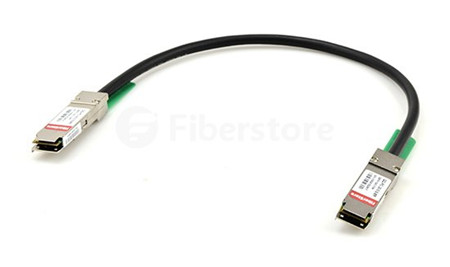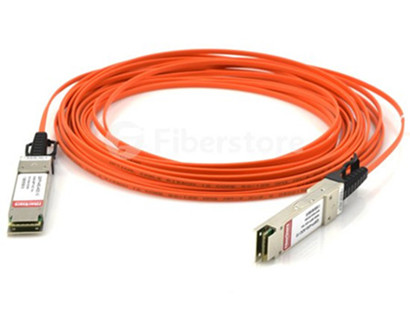40GbE network is now the new trend for higher data transmission. As a result, 40G optical devices are sprang up like mushrooms, Of which QSFP+ transceiver modules and 40G AOC/DAC are mostly favored by subscribers. 40G direct attach cable provides a cost-effective solution for high-density network connectivity. In today’s blog, we are going to focus on some basic information about 40G direct attach cables.
Introduction to Direct Attach Cables
Direct attach cable (DAC) is a form of high speed cable with “transceivers” on either end used to connect switches to routers or servers. It a kind of optical transceiver assembly. DAC cables are not real optics and their components are without optical lasers. DACs are much cheaper than the regular optics. Because of their low cost, low power consumption and high performances, DAC cables are the preferable choice for storage area network, data center, and high-performance computing connectivity.
Direct attach cable (DAC) is a form of high speed cable with “transceivers” on either end used to connect switches to routers or servers. It a kind of optical transceiver assembly. DAC cables are not real optics and their components are without optical lasers. DACs are much cheaper than the regular optics. Because of their low cost, low power consumption and high performances, DAC cables are the preferable choice for storage area network, data center, and high-performance computing connectivity.
For 40G DAC Cables—Active or Passive?
DAC Cables are designed in either active or passive versions. They are widely available in telecom field. 40G DAC cables transmit 40GbE over short distances of parallel coaxial copper cabling. It uses a special cabling assembly with four lanes of coaxial cabling. Four pairs each transmit 10 Gbps in one direction and four transmit 10 Gbps in the other direction for a total data rate of 40 Gbps. QSFP to QSFP and QSFP to 4 SFP+ copper direct-attach cables are the two common types of 40G DAC cables.
DAC Cables are designed in either active or passive versions. They are widely available in telecom field. 40G DAC cables transmit 40GbE over short distances of parallel coaxial copper cabling. It uses a special cabling assembly with four lanes of coaxial cabling. Four pairs each transmit 10 Gbps in one direction and four transmit 10 Gbps in the other direction for a total data rate of 40 Gbps. QSFP to QSFP and QSFP to 4 SFP+ copper direct-attach cables are the two common types of 40G DAC cables.
For example, Arista 40G QSFP+ cables deploy both active copper cables and passive copper cables. Take closer look at CAB-Q-Q-0.5M, it is the compatible Arista CAB-Q-Q-0.5M (see in Figure 1) QSFP+ to QSFP+ copper direct-attach cables. It is suitable for very short distances and transmit over passive copper cables for 40-gigabit link.

Active optical cables is short for AOC. AOC uses electrical-to-optical conversion on the cable ends to improve speed and distance performance of the cable while mating with electrical interface standard. Compared with direct attach copper cables, its smaller size, longer transmission distance, lower insertion loss and electromagnetic interference immunity make it popular among subscribers. Arista AOC-Q-Q-40G-3M (see in Figure 1) operates over active optical cables for higher performance in 40 Gigabit Ethernet.


Comparison Between Passive and Active
A debate that whether you should choose optical cable over cooper or verse is the long-term unresolved problems existed in telecommunication industry. Just like that, people are wondering whether to choose passive or active version of fiber optic cables. Passive cabling provides a direct electrical connection between corresponding cable ends and it contains no active components to boost signal. Active cables provide the same effect but, by embedding optics and/or electronics within the connectors, can overcome some of the limitations of passive cables. While passive cables are always copper-based, active cables can use either copper wire or fiber optics to provide the link between the cable ends.
A debate that whether you should choose optical cable over cooper or verse is the long-term unresolved problems existed in telecommunication industry. Just like that, people are wondering whether to choose passive or active version of fiber optic cables. Passive cabling provides a direct electrical connection between corresponding cable ends and it contains no active components to boost signal. Active cables provide the same effect but, by embedding optics and/or electronics within the connectors, can overcome some of the limitations of passive cables. While passive cables are always copper-based, active cables can use either copper wire or fiber optics to provide the link between the cable ends.
Conclusion
The 40 Gigabit Ethernet is already upon us and makes a great contribution to satisfying the increasing needs of higher bandwidth. 40G Direct Attach Cables cables, a great way to support 40GbE, were warmly welcomed by subscribers. Fiberstore supplies various kinds of DAC cable assemblies including 10G SFP+ Cables, 40G QSFP+ Cables, and 120G CXP Cables. All of direct attach cables can meet the ever increasing need to cost-effectively deliver more bandwidth, and can also be customized to meet different requirements.
The 40 Gigabit Ethernet is already upon us and makes a great contribution to satisfying the increasing needs of higher bandwidth. 40G Direct Attach Cables cables, a great way to support 40GbE, were warmly welcomed by subscribers. Fiberstore supplies various kinds of DAC cable assemblies including 10G SFP+ Cables, 40G QSFP+ Cables, and 120G CXP Cables. All of direct attach cables can meet the ever increasing need to cost-effectively deliver more bandwidth, and can also be customized to meet different requirements.
评论
发表评论